This discussion of visual perception is part of an introduction to media theory. The prime concern here is with how mediated our experience of the world is. The study of visual perception offers considerable evidence that the world or the image is not 'given', as people sometimes say, but constructed. In visual perception we are not like passive cameras, and even the idea that the mind takes selective 'snapshots' underplays our active interpretation of the world. These notes focus on key factors which contribute to shaping what we see.
The distinctiveness of human vision
It is worth reminding ourselves that 'the world' which we often regard as objectively 'out there' is experienced in very different ways by other creatures.
Sight dominates the way we 'see' the world. It even dominates our descriptive vocabulary. We don't know how other creatures see the world, though we do know how eyes differ in the animal kingdom amd we know that different animals vary in their reliance on vision. Of course, some creatures don't 'see' the world at all. And many creatures rely far less on vision than we do (e.g. bats, dolphins). Most mammals live in more of a world of scent than of sight. We share our reliance on sight more than scent with other primates. However, of all vertebrate animals, birds are the most dependent on sight.
Flies have what are called 'compound eyes', but it's likely to be a myth that they see multiple images. However, if we had the eyes of a fly we would see television images as separate frames, since TV images are displayed at 25 frames per second, which for the rapid scanning eye of the fly is quite slow. Although the image can be misleading, our eyes are typically described in contrast to 'compound eyes' as being 'camera-style' eyes. Animals with such eyes comprise less than 6% of the species in the animal kingdom; more than 77% are insects and crustaceans with compound eyes.
Animals differ in visual acuity. Insects are short-sighted whereas a kestrel can spot a mouse from 1.5 km up. Hawks can spot prey 8 times further away than human beings can. The range of distances that animals can focus on is measured in dioptres. We have a good focal range (or 'accommodation') compared with most mammals. A child's range is about 14 dioptres, though an old person's is about 1 dioptre. Many creatures have poor accommodation or none. A dog copes with 1 dioptre. However, diving birds have 50 dioptres - the greatest of all animals.
Most invertebrates don't need to accommodate - sight involves short focal length and great depth of field - keeping everything in equal focus (though without much fine detail). A bee can see things from an inch or so away whereas we can't focus on things much under 6 inches away (without a magnifier). The 'f-number' of human eyes is about 2.55, whilst a standard camera lens has an f-number of 1.8. The most sensitive is a deep-sea crustacean, Gigantocypris (f-0.25), but its eyes are small, and so the quality of vision is limited.
The position of the eyes on the head also varies amongst animals. Eye position controls the extent of the field of view when the head is stationary, and also the possibility and extent of binocular vision. When the eyes are on either side of the head, the view is almost panoramic, but there is a loss of stereoscopic depth perception. Hunting animals tend to have a broader field of binocular vision. Hunted animals tend to have a far broader field of view. Hunters tend to have a much larger 'blind area' behind the head than hunted animals do. Humans have a total field of view of somewhere between 160-208 degrees, about 140 degrees or so for each eye and a binocular field of 120-180 degrees. A dog has a total field of view of about 280 degrees, 180-190 degrees for each eye and 90 degrees of binocular field. A hare has a total field of view of 360 degrees, 220 degrees for each eye, with only 30 degrees of binocular field in front and 10 degrees behind the head.
Some humans can distinguish 250 colours. Whilst some mammals are colour-blind, birds probably see more colours than we do. The desert ant has the most refined colour system amongst insects and can discriminate between colours we can't see. As we age our lenses grow more yellow and filter out some of the violet. Many insects are sensitive to ultraviolet light; vertebrates are not. We know that the colour vision of bees is different from ours, bees being highly sensitive to ultraviolet light and insensitive to red light. Many insects, fish and birds can see beyond violet into ultraviolet radiation. Ultraviolet light gives flowers such as the yellow daisy a bright glowing core for honey-bees. At the other end of the spectrum of electromagnetic energy, some snakes are sensitive to infra-red which they use to detect the presence of warm-blooded animals. Some freshwater fish can see far further into the red or longer wavelength part of the spectrum than we can. If our eyes were as sensitive as those of goldfish we'd see the infra-red beams that control our TVs and videos. Whilst we are not sensitive to polarized light, many other animals are, and must therefore see the sky as having a far more intricate pattern than we are aware of. Of course, we can use tools to temporarily extend the visibility of the spectrum.
No creature sees fine detail in darkness, but some other creatures have far better 'night sight' than we do (e.g. foxes, cats and owls). Creatures with good night sight typically have the reflective 'eye-shine' that we often notice. It is this which allows them to make the most of whatever light there is. Owls have a sensitivity to low light intensities 50-100 times greater than that of unaided human night vision. Cats' eyes catch 50% more light than ours and are eight times more sensitive than ours at night. But such sight is typically supplemented by other senses. And even within vision, movement is the key for some creatures: the eyes of such creatures as the bee and the frog are very sensitive to movement.
Different creatures vary in the amount of the brain which is devoted to vision. Over half of the brain of the octopus and the squid is devoted to vision. But we still don't know how other creatures make sense of what their eyes detect. No single creature can see all that others can. We often forget that the human world of sight is only one such world.
Ocularcentrism
Amongst the senses, Plato gave primacy to sight. When he decided that we had five senses, Aristotle ranked sight over hearing: 'Of all the senses, trust only the sense of sight'. Plato and Aristotle closely associated vision and reason. This has been a persistent bias in Western culture. Thinking is associated with visual metaphors: 'observation' privileges visual data; phenomenon (Greek: 'exposing to sight'); definition (from definire, to draw a line around); insight, illuminate, shedding light, enlighten, vision, reflection, clarity, survey, perspective, point of view, overview, farsighted. Other words associated with thinking also have visual roots: intelligent, idea, theory, contemplate, speculate, bright, brilliant, dull. And there is no shortage of commonly-used phrases which emphasize the primacy of the visual:
- Seeing is believing
- Let me see, I see
- I'll believe it when I see it with my own eyes
- Seeing eye to eye
- It's good to see you
- Love at first sight
- What does she see in him?
- In the mind's eye
- Draw your own conclusions
- See what I mean?
When students in one study were asked to list the sense they'd least like to lose, 75% listed sight.
It is likely that the spread of literacy in modern times has helped to privilege sight.
Homo signifificans
I have emphasized that the world is 'seen' in different ways by different creatures, and that human beings in the modern world have come to give primacy to the visual. We do not always 'believe our own eyes' - we know that a pencil in a glass only appears to be bent, that the moon only appears to be larger when it is near the horizon and that there are such things as optical illusions.
Now I would like to emphasize that we seem as a species to be driven by a desire to make meanings: I suggest that we are, above all, Homo significans - meaning-makers. This fundamental concern underlies the process of human visual perception. Faced even by 'meaningless' patterns the mind restlessly strives to make them meaningful. Look at this image for a few moments...
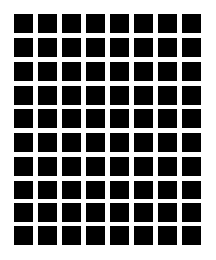
It is hard not to start 'seeing things' in this abstract geometrical arrangement. The spacing is even, but we may start to see rows, or columns, or small groupings - such as of 4 black squares. We restlessly shift from one way of patterning to another - in this case none is likely to seem much more meaningful than another so we quickly tire of looking at such a frustrating image. (Yes, and you can see grey areas at the intersections - a point to which I will refer in a later lecture).
Here is another repetitive arrangement...

This time, you are more likely to impose a particular grouping on what you see. People tend to refer to five pairs of lines which are close together with fairly broad gaps between them. You are less likely to group together the lines which are further apart, perhaps partly because this would leave lonely lines on each side of the image, but also (as we will see in a later lecture) because we seem to have a predisposition to associate things which are close together.
 At this stage, it is useful to note that theories about perception tend to
emphasize the role of either sensory data or knowledge in the
process. Some theorists adopt a data-driven or 'bottom-up' stance, according
to which perception is 'direct': visual data is immediately structured in the
optical array prior to any selectivity on the part of the perceiver
(James J Gibson is the key proponent of 'direct perception').
Others (e.g. Richard L Gregory) adopt a 'constructivist'
or 'top-down' stance emphasizing the importance of prior knowledge and
hypotheses. Both processes are important: if we were purely data-driven we
would be mindless automatons; if we were purely theory-driven we would be
disembodied dreamers.
At this stage, it is useful to note that theories about perception tend to
emphasize the role of either sensory data or knowledge in the
process. Some theorists adopt a data-driven or 'bottom-up' stance, according
to which perception is 'direct': visual data is immediately structured in the
optical array prior to any selectivity on the part of the perceiver
(James J Gibson is the key proponent of 'direct perception').
Others (e.g. Richard L Gregory) adopt a 'constructivist'
or 'top-down' stance emphasizing the importance of prior knowledge and
hypotheses. Both processes are important: if we were purely data-driven we
would be mindless automatons; if we were purely theory-driven we would be
disembodied dreamers.
We have all heard of the psychoanalyst's 'Rorshach Inkblots'. These were of course intended to be very much open to interpretation. The idea was that what people reported seeing in these images involved some projection of their own deep concerns. Here is one such blot...
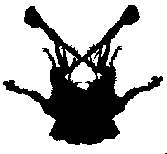
We all seem to 'see things' in inkblots, flames, stains, clouds and so on. Some of us may, of course, be more 'suggestible' than others...
-
Hamlet: Do you see yonder cloud that’s almost in shape of a camel?
Polonius: By the Mass, and ‘tis like a camel indeed.
Hamlet: Methinks it is like a weasel.
Polonius: It is backed like a weasel.
Hamlet: Or like a whale?
Polonius: Very like a whale.
Hamlet (Act II, Scene II)
Some images are more open to interpretation than others. Most of us would see no 'intended reading' in such natural phenomena as flames and clouds (though this wouldn't stop us seeing meaningful patterns in them). We would generally accept that there is typically less openness to interpretation when it comes to images deliberately designed by human beings. The declaration that a road sign is 'open to interpretation' is not likely to be much of a defence for ignoring its intended meaning in the eyes of the law! On the other hand, we would usually feel free to be fairly free-ranging in our interpretation of an image which we knew to be intended as a work of art.
Here is another black and white image. For some people it will be immediately obvious - others may not instantly recognize it.
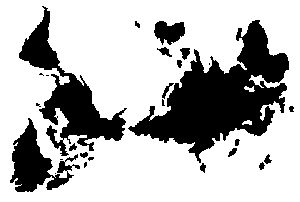
Familiar as this image is, whilst we may recognize it as a map, we may not immediately recognize it as representing the world (upside down, according to the way we're used to seeing it). However, once we 'know what to look for', we have no difficulty seeing it as a map of the world which happens to be upside down.
The illustration below is well-known from psychology textbooks, so most students will already know what to look for in it.
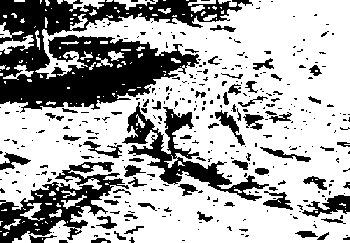
Those who haven't seen it before shouldn't have too much difficulty if they are told that there is a dalmation dog nosing around on a path near a tree. The dog is in the centre of the picture, facing the top-left corner. Often, significant details seem to suddenly lead to the 'click' of recognition, at which point it is hard to understand why we hadn't seen the 'hidden' image in the first place. On subsequent occasions we see the image without any of our initial difficulty.
Sometimes images are neither open to almost any interpretation nor constrained to a single 'preferred interpretation'. Some of the images used in the study of visual perception have been carefully designed to be interpreted in two different but specific ways. Look at the following example, for instance.
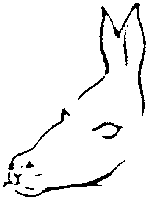
At first sight, this may seem to be either a seal or a donkey (alternatives which we would be unlikely to confuse in real life). Here, you will initially see either a seal or a donkey, but not both at once. You bring your own preferred interpretation to the image - a phenomenon known to psychologists as perceptual set (this will be discussed in a later lecture). In cases where one alternative interpretation repeatedly elicits far more support than the other, it might be said that the image itself has a preferred interpretation (though this might be culturally-specific).
Here is another example, though this may be more well-known from psychology textbooks...
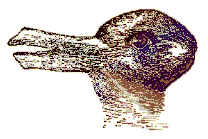
Here the intended alternatives are a duck and a hare. What do you see first? Such examples demonstrate that your own preferred interpretation is part of what you bring to making sense of an image. In the context of media theory, the relative openness of images to interpretation can serve as a reminder that the 'meaning' of an image cannot be simply equated with a universal, unitary, fixed and objective 'content' - meaning is not 'extracted' but is constructed in the process of interpretation. But such constructed meanings are not unconstrained: if you reported in all seriousness that your interpretation of the image shown above was an elephant, you would be in danger of being regarded as either mentally deficient or insane.
-
Visual Perception 1: Searching for Patterns
-
Visual Perception 2: The Third Dimension
-
Visual Perception 3: Selectivity and Perceptual Constancy
-
Visual Perception 4: Cultural and Environmental Factors
-
Visual Perception 5: Individual Differences, Purposes and Needs
-
Visual Perception 6: Context and Expectations
-
Visual Perception 7: Gestalt Principles of Visual Organization
-
Visual Perception 8: The Moving Image
-
References and Suggested Reading

|